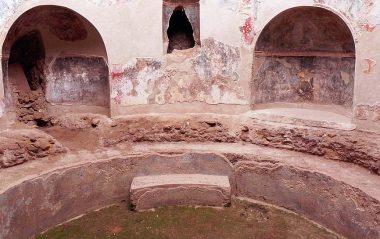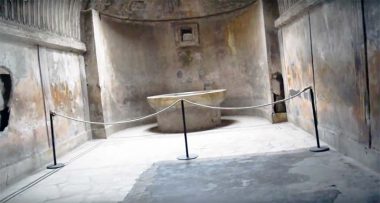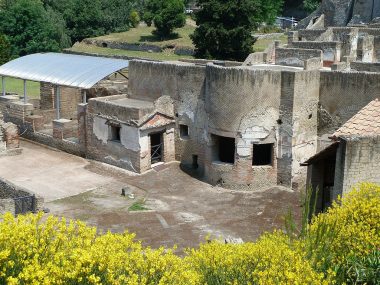The five large thermal baths in ancient city of Pompeii show us how much the bathing culture was developed in the ancient Roman society. Bathing culture was an important bond of Roman society because the thermal baths were not used only to rest body and mind, moreover social relations were also developed in those baths. In fact, thermal public baths were a place of many activities like sports activities, massage rooms and sometimes even libraries. Ancient Roman bathrooms usually had direct access to taverns and back door often led to a nearby entertainment establishment. The ancient city Pompeii, with around of 11.000 to 20.000 inhabitants, had five large thermal baths and each bath could accommodate about 1.000 guests. The thermal baths in Pompeii were among the best preserved of antiquity and these baths provide informations about the development of the early bathing culture. Each thermal bath was typically consists of the following: apodyterium or changing room, tepidarium or lukewarm room while frigidarium represents cold room and caldarium hot room.
Stabian thermal bath



Stabian thermal bath was the oldest bath in Pompeii. This bath was built towards the end of the 4th century BC on the oldest Paleastra (or Palestra – meaning the place for athletic, gymnastic and wrestling). The soothing effect of a bath after sport was in early stage still in the foreground. Until the devastating earthquake in 62 AD, the Stabian thermal baths were constantly renovated and expanded. The water supply and the heating system have been constantly updated with the latest technique improvements. In addition, were gradually build new rooms with different water temperatures. The gentlemen and ladies sections were strictly separated and had separate entrances. The gentlemen section being much larger and more comfortable compared to ladies one. The Stabian thermal spa were integrated into the surrounding buildings and could not be recognized as such from the street. But later the main entrance on the Via Stabiana (Stabian Street) was marked with this bath. The sunlight in Stabian bath came however only through the open Palaestra. The bathrooms were probably relatively dark, but decorated with numerous colorful murals and reliefs.
Forum thermal bath



The Forum thermal bath was built around the first century BC. As the name suggests, it was built initially for the needs of the Forum and it stands behind Temple of Jupiter. In the beginning bath was decorated with partly naked human bodies, animals and mythological heroes. The Forum thermal baths was build in time when the city of Pompeii could no longer resist against the Rome. So, after Lucius Cornelius Sulla achieved victory in Campania, city of Pompeii became the Roman colony and thermal bad used by the Roman colonists who worked in Pompeii. The warm water was heated on the northern part of the bathroom where was located the central heating system (hypocaust). Hot water passed through the pipes directly to bath. South of this there was an old well, which was used in pre-Augustan (Octavian Augustus) period to supply the hot springs with water. On the southern side of the “Forum thermal bath” the old water well was used before the hypocaust was build. In the beginning only bathrooms for men were build and women’s bath was build later.
Suburban thermal baths
The suburban thermal bath were built in the early imperial period of Rome. It was located on the main road to the neighboring city of Herculaneum. Recreation and pleasure were clearly in the foreground here – the architecture of the baths shows less functional, but all the more representative elements like the older thermal baths.



The bathrooms were large and bright. Through the huge glass windows visitors in the bath had a view of the sea. The suburban baths were known within erotic scenes on the walls. After visitors passes through the main entrance they entered in dressing room (apodyterium). In the changing room, various frescoes with pleasurable depictions of the love act spread over the entire wall. On the one hand, the walls with different pictures had very practical reasons, because the different images made it easier to find the discarded clothes. The erotic motifs were extremely popular at the time and it was based on contemporary literature such as elegy “Ars amatoria” written by ancient Roman poet Ovid (Publius Ovidius Naso). On the other hand, the illustrations also suggest that there was unofficial brothel activities in the thermal baths because for such offensive murals within erotic scenes can be found in Pompeii only in certain buildings. There is no clear evidence for that inside but outside of the one door archaeologists found a Phallus (erected penis) or phallic symbol.
Central Thermal Baths
The construction of the Central thermal baths or “Terme Centrali” in Pompeii was started after the great earthquake in 62 AD. But 17 years later the construction of the Central thermal baths were not completed because scientists concluded that this baths was still in construction phase at the time of the great volcanic eruption of Vesuvius in 79 AD. But even in the construction phase, the Central baths shows significance and growing of the bathing culture. The Central thermal baths were the largest construction planned after 62 AD within the modern technologies of heating at that time, light-flooded rooms and arts on the walls. The remnants of the shell reveal no separate tracts for men and women, so it can be assumed that the large rooms were intended for mixed bathing.
Sarno Thermal Baths
Sarno Thermal Baths represent a multi-functional complex of the baths and houses. It was located at the place where two streets Via della Regina and Via delle Scuole were connected. It was the complex consist of the luxuries apartments and baths. Sarno thermal Baths had one public entrance and two private ones. This bathroom was named after paintings on the wall depicting the Sarno River and it was build around II century BC. As the others baths Sarno Thermal Baths also suffered damage caused by earthquake in 62 AD. These bathrooms are still not completely explored by scientists. For this reason, researchers started a new research project in 2017 in order to better understand Sarno Thermal Baths from the point of the archeology.
Public and private Baths
The large public baths in Pompeii were accessible to people from all walks of life. The only difference between rich and poor people in public baths was that rich people could take a servant to the baths. Servants were kept belongings of the rich people, while the poorer always could have expected to go home without their clothes. Some rich people had build a private thermal baths but its only a few buildings in Pompeii like the luxuries baths in large villa which was once owned by woman Julia Felix.
References:
- Inge Nielsen, Thermae Et Balnea: The Architecture and Cultural History of Roman Public Baths, 1990.
- Garret G. Fagan, Bathing in Public in the Roman World, Michigan 1999.
- Eschebach, Hans: Mielsch, Harald: Die Stabianer Thermen in Pompeji. Berlin 1979.
